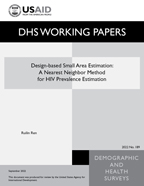- PUBLICATIONS
- JOURNAL ARTICLES
- ACCESS PUBLICATIONS
Publications Summary
- Document Type
- Working Papers
- Publication Topic(s)
- HIV/AIDS
- Country(s)
- Rwanda
- Language
- English
- Recommended Citation
- Ren, Ruilin. 2022. Design-based Small Area Estimation: A Nearest Neighbor Method for HIV Prevalence Estimation. DHS Working Papers No. 189. Rockville, Maryland, USA: ICF
- Download Citation
- RIS format / Text format / Endnote format
- Publication Date
- September 2022
- Publication ID
- WP189
Download
 Design-based Small Area Estimation: A Nearest Neighbor Method for HIV Prevalence Estimation (PDF, 751K)
Design-based Small Area Estimation: A Nearest Neighbor Method for HIV Prevalence Estimation (PDF, 751K)
Download this publication
There is no printed copy available to order.
